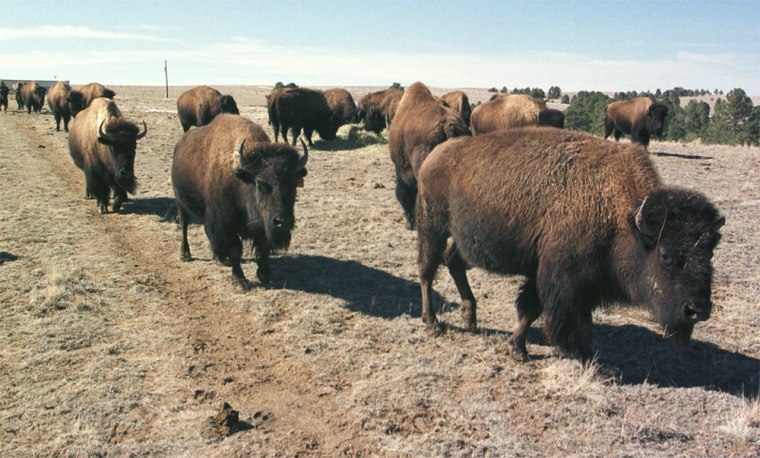The buffalo meat market already was on an upswing when the U.S. government announced Dec. 23 that a single cow in Washington state had tested positive for mad cow disease.
But since the announcement, which sent commodity cattle prices plunging, the bison industry has been hanging onto a wild ride and hoping the last month's increase in inquiries and sales will translate into long-term market share.
"The last few weeks, the question of the hour has been 'Is this going to last?'" said Bob Dineen, president and founder of Rocky Mountain Natural Meats, which sells bison meat to grocery store chains such as Whole Foods and Wild Oats.
"I don't know how to answer that. Hopefully we gain some new customers. We don't compete with the beef industry. We're an alternative."
The number of inquiries about bison meat rose immediately after the announcement two days before Christmas, but in the weeks since, the inquiries have translated into additional sales, say buffalo meat marketers.
"Every order we received, we had a second call saying they needed to increase the order," Dineen said.
Ted's Montana Grill, a national restaurant chain founded by media mogul Ted Turner and partners, reported sales of bison entrées soared 30 percent over the previous week's sales, Dineen said.
The animals technically are bison, not buffalo, in North America. But marketers are using the terms interchangeably because they say more people are familiar with buffalo than bison.
At Denver-based North American Provisioners, more restaurants are calling and requesting samples of steaks and burgers, said Jim Bernat, national food service sales manager for the company, the marketing arm of the North American Bison Cooperative based in North Dakota.
"They're opening communication channels in case something happens and they have to go to an alternative protein to serve," Bernat said.
Marketers and buffalo producers believe the announcement about mad cow disease being discovered in the United States was the "tipping point" for people who were already interested in trying buffalo meat, but hadn't bought any.
Buffalo producers stress they think the U.S. beef supply is safe. But there's no question the announcement has spurred interest in buffalo meat.
"We don't think BSE [bovine spongiform encephalopathy, or mad cow disease] is as widespread as some people believe, but at the same time it's given the bison industry a needed boost," Dineen said.
The industry's turnaround from a multiyear slump actually started in the spring and summer of 2003, buffalo producers say. They attribute the rising demand for buffalo to a number of factors, including increased advertising, the popularity of the meat-heavy Atkins diet and the smaller price gap between beef and buffalo.
"It's the highest demand that we've ever seen for this industry," Dineen said.
Retail sales to grocery stores in 2003 were up 50 percent or more from 2002, said Ed Morrissey, national retail sales manager for North American Provisioners. Bernat said food service sales were up 35 percent.
The price gap also has narrowed.
Typically, buffalo meat has been 20 percent to 25 percent more expensive than beef. But with the higher beef prices in 2003, the difference between the two almost evaporated, Morrissey said.
Peter Popp, who runs the Black Forest Bison ranch near Larkspur in Douglas County, Colorado, said his 2003 sales were up 150 percent to 200 percent from 2002. He declined to give dollar figures.
The ranch has a herd of 50 or 60 bison and its partner has a 5,000-acre spread with a herd of 500 to 700 head in Nebraska, said Popp, a niche marketer who sells most of his organically raised, grass-fed bison meat via the Internet.
Business has been so good, the ranch opened a tiny retail store on Highway 83 in Douglas County to sell bison meat.
"I really expected things to drop off. The retail store had planned to close after mid-December, then the third week of December, then we were getting calls asking us to ship in time for New Year's Eve. Some people this week have called and said they loved [their Christmas gifts] and want more," Popp said. "We've never closed."
All told, 2003 was a record year in terms of buffalo slaughter, with 32,000 animals turned into meat -- a 25 percent increase from 2002 and a 63 percent increase from 2001, said Dave Carter, executive director of the National Bison Association.
The question for the future is whether the industry, which takes two years to raise a buffalo calf to market weight, can meet any sudden increased demand.
"The last couple weeks, things have really started to pop," Carter said. "Some of our marketers are really scrambling to find meat to fill their orders."
If demand continues to grow, some breeding stock typically held back might end up on the market, or prices for buffalo meat could rise, buffalo producers say.
But even with all the increased interest in buffalo meat, the bison industry is still small.
The 32,000 bison sent to market in all of 2003 is dwarfed by the 130,000 head of cattle sent to market every day, Carter said.
Yet the bison industry's small size has an advantage when it comes to coping with mad cow disease. It's so small that instituting a trace on every animal raised and sent to market -- which the industry has been working on for two years -- is easier than creating one for the cattle industry, he said.
